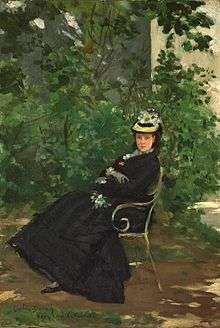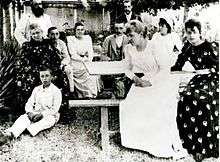Alice Hoschedé
Alice Raingo Hoschedé Monet (February 19, 1844 – May 19, 1911) was the wife of department store magnate and art collector Ernest Hoschedé[1] and later of the Impressionist painter Claude Monet.[2]


Early life
According to unsourced genealogical data reported by Michael Legrand, she was born Angélique Émilie Alice Raingo on February 19, 1844, in Paris to Denis Lucien Alphonse Raingo and his wife Jeanne Coralie Boulade.[3]
Marriage to Ernest Hoschedé
After meeting her future daughter-in-law in 1863, Ernest Hoschedé's mother wrote of Alice:
This young woman has wit, intelligence in plenty and, I believe, strength of will. Her conversation is easy, though I find her voice rather loud. She seemed to me more delicate and prettier than in her photograph.[2]
Her children (by Ernest Hoschedé) were Blanche (who married Claude's son, Jean Monet), Germaine, Suzanne, Marthe, Jean-Pierre, and Jacques.[4]
Life with the Monet family
In 1876, Ernest Hoschedé commissioned Monet to paint decorative panels for the Château de Rottembourg[5] and several landscape paintings. According to the Nineteenth-century European Art: A Topical Dictionary, it may have been during this visit that Monet began a relationship with Alice and her youngest son, Jean-Pierre, may have been fathered by Monet.[6] [nb 1]
Ernest Hoschedé went bankrupt in 1877.[8] Ernest, Alice, and their children moved into a house in Vétheuil with Monet, Monet's first wife Camille, and the Monets' two sons, Jean and Michel.[9] Ernest spent increasing lengths of time in Paris.[7] He then lived in Paris and worked at le Voltaire.[10]
.jpg)
There are times when Ernest Hoschedé returns to visit his wife and children at the successive Monet households of Vetheuil, Poissy and Giverny. During those times Monet leaves the household. The separation from Alice, though, leaves Monet greatly distressed, experiencing nightmares, and generally unable to paint.[11]
Monet's last campaign at Etretat coincides with the presence of Ernest Hoschedé at the birthday celebration of his wife at Giverny. Monet is "annihilated" by this development, and although he acknowledges that it would be better not to send Mme Hoschedé such a bleak account, he cannot resist acquainting her of his pain. Along with obsessive thoughts of her, Monet also claims to have unceasing concern for "our two little ones, so cute and nice". The reference is to Camille Monet's son Michel (b. 1878) and Alice Hoschedé's son Jean-Pierre (b. 1877); the implication here and elsewhere in the correspondence may be that Monet is the father of both.
— Steven Z. Levine[11]
Before the Monet and Hoschedé families had moved to Poissy, Ernest Hoschedé had refused to pay his share of the upkeep for Alice and the children.[12] In 1886 had showed up and demanded that his wife and children return with him to Paris, but Alice remained with Monet.[13]
Relationship with Claude Monet

After Camille Monet's death in 1879, Monet and Alice (along with the children from the two respective families) continued living together at Poissy and later at Giverny.[9] Still married to Ernest Hoschedé and living with Claude Monet, the Le Gaulois newspaper in Paris declared that she was Monet's "charming wife" in 1880.[14]
Ernest Hoschedé died in 1891 and Alice agreed to marry Monet in 1892.[15]
Madam Hoschedé came from an upper-middle-class family, and despite the irregular character of her relationship with Monet (until their marriage in 1892) she brought their home an element of respectability that the people of the village could accept more easily than they might have the casual, vaguely scandalous air of an "artistic" household... With affectionate authority she supervised the education not only of her own six children but of Monet's two sons.[16]
— Monet's Years at Giverny: Beyond Impressionism, Metropolitan Museum of Art
Alice died in 1911.[17]
Paintings of Alice
Some of the paintings of Alice Hoschedé Monet are:[6]
- Claude Monet, Breakfast under the Tent, Giverny, 1888
- John Singer Sargent, Mme Hoschedé and Her Son in Monet's Garden, Giverny
- John Singer Sargent, Claude Monet Painting
In popular culture
Amanda Root portrayed Hoschedé in the 2006 BBC docudrama The Impressionists.
See also
Notes
- Jean-Pierre was born nine months after Monet had been left alone with Alice Hoschedé in her chateau during the summer and autumn months.[7]
References
- Street Singer Provenance Information. Museum of Fine Arts, Boston. Retrieved August 27, 2014.
- Museyon Guides (1 July 2011). Art + Paris Impressionists & Post-Impressionists: The Ultimate Guide to Artists, Paintings and Places in Paris and Normandy. Museyon Guides. p. 30. ISBN 978-1-938450-24-2.
- "Michael Legrand Genealogy". GeneaNet.
- Museyon Guides (1 July 2011). Art + Paris Impressionists & Post-Impressionists: The Ultimate Guide to Artists, Paintings and Places in Paris and Normandy. Museyon Guides. p. 266. ISBN 978-1-938450-24-2.
- Sue Roe (2006). The private lives of the impressionists. New York: Harper Collins Publishers. p. 157. ISBN 0-06-054558-5.
- Terry W. Strieter (1999). Nineteenth-century European Art: A Topical Dictionary. Greenwood Publishing Group. pp. 103–104. ISBN 978-0-313-29898-1.
- Mary McAuliffe (16 May 2011). Dawn of the Belle Epoque: The Paris of Monet, Zola, Bernhardt, Eiffel, Debussy, Clemenceau, and Their Friends. Rowman & Littlefield Publishers. p. 81. ISBN 978-1-4422-0929-9.
- Christopher Heinrich (2000). Monet. Taschen. p. 54.
- Museyon Guides (1 July 2011). Art + Paris Impressionists & Post-Impressionists: The Ultimate Guide to Artists, Paintings and Places in Paris and Normandy. Museyon Guides. pp. 23, 29–30. ISBN 978-1-938450-24-2.
- "Camille Doncieux". monetpainting.net. Retrieved 29 August 2014.
- Steven Z. Levine; Claude Monet (January 1994). Monet, Narcissus, and Self-Reflection: The Modernist Myth of the Self. University of Chicago Press. pp. 27, 53. ISBN 978-0-226-47544-8.
- Mary McAuliffe (16 May 2011). Dawn of the Belle Epoque: The Paris of Monet, Zola, Bernhardt, Eiffel, Debussy, Clemenceau, and Their Friends. Rowman & Littlefield Publishers. p. 113. ISBN 978-1-4422-0929-9.
- Mary McAuliffe (16 May 2011). Dawn of the Belle Epoque: The Paris of Monet, Zola, Bernhardt, Eiffel, Debussy, Clemenceau, and Their Friends. Rowman & Littlefield Publishers. pp. 165–166. ISBN 978-1-4422-0929-9.
- Museyon Guides (1 July 2011). Art + Paris Impressionists & Post-Impressionists: The Ultimate Guide to Artists, Paintings and Places in Paris and Normandy. Museyon. p. 30. ISBN 978-0-9822320-9-5.
- "The Monet You Don't Know". New York Sun. April 28, 2007.
- Monet's Years at Giverny: Beyond Impressionism. Metropolitan Museum of Art. 1978. p. 16. ISBN 978-0-87099-174-5.
- "Claude Monet biography". giverny.org. Archived from the original on 2007-06-21. Retrieved 2008-01-23.